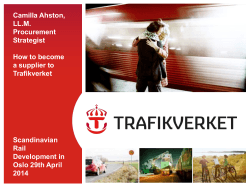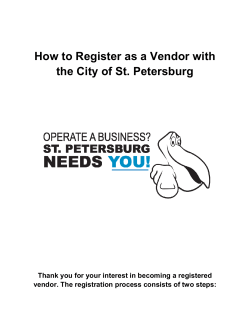
How to participate to H2020 What changes from FP7 Morten Møller
European Commission How to participate to H2020 What changes from FP7 Morten Møller Head of Programme Coordination Unit DG CONNECT European Commission 1 Coherence Simplification European Commission 1. A SINGLE SET OF RULES: the overarching principle SINGLE SET OF RULES for Horizon 2020 • Covering all research programmes and funding bodies EU Financial Regulation (art.185 initiatives, art. 187 initiatives, CIP, EIT)… …but flexible to accommodate specificities where needed. • In accordance with the new Financial Regulation and its Rules of Application. …ETC • Coherent with the rules of the other EU programmes. • Also applicable to Euratom. 2 Simplification European Commission Maximum reimbursemen t rates 2. A SINGLE FUNDING RATE (Art. 22) Research and technological development activities (*) Network of excellence 50% 75% (**) Collaborative project(****) 50% 75% (**) Coordination and support action Demonstration activities Other activities One project = One rate 100% 50% 100% Same rate for all beneficiaries and all activities in the grant. The applicable rate will be defined in the Work Programme: 100% (***) (*) Research and technological development includes scientific coordination. (**) For beneficiaries that are non-profit public bodies, secondary and higher education establishments, research organisations and SMEs (***) The reimbursement of indirect eligible costs, in the case of coordination and support actions, may reach a maximum 7% of the direct eligible costs, excluding the direct eligible costs for subcontracting and the costs of resources made available by third parties which are not used on the premises of the beneficiary. (****) Including research for the benefit of specific groups (in particular SMEs) Up to 100 % of the eligible costs; but limited to a maximum of 70 % for projects “close to market”. 100 for non-profit organisations! 3 3. FORMS OF FUNDING European Commission What would remain from Grant Agreements as the main funding stream (also possibility of Grant Decisions). Reimbursement of costs as the main funding method. What would be Specific provisions for new forms of funding targeting innovation: precommercial procurement, procurement of innovative solutions and inducement prizes. Financial instruments: a debt financial instrument, a financial instrument providing equity finance for R&I, etc. Possibility of output-based grants (lump-sums per project). Enhanced use of other lump-sums, flat rates and scales of unit. Electronic signature of Grant Agreements (and expert contracts) 4 Coherence Simplification European Commission 4. COST REIMBURSEMENT PERSONNEL COST Wider acceptance of average personnel costs (now under scale of unit costs, Art. 27) Minimizing in Horizon 2020 the basic conditions for acceptance of average personnel cost accounting practices (including cost-centre approaches). Acceptance of supplementary payments (bonus+) with 8000 Euro-cap/annum Simplifying participation for SMEs (Art. 26) Providing in the Rules for a scale of unit system for SME owners and physical persons without a salary. Less requirements for time records (Art. 25) No time records for researchers working exclusively in the project. …and more in the Horizon 2020 Grant Agreement The Grant Agreement will add further elements of simplification regarding personnel costs like simplified provisions on productive hours and clear minimum rules on time-recording. INDIRECT COSTS Unique method: 25 % flat-rate (Art. 24) Aiming at simplifying the financial rules and reducing the recurrent errors in the calculation of the indirect costs, frequently leading to liquidated damages and extrapolation. 5 Coherence Simplification European Commission 5. CONTROLS AND AUDITS Financial viability Most beneficiaries exempt from detailed analysis; only systematic check for coordinators when requested EU funding for the project is ≥ 500 k€ Only for final payments when total EU contribution claimed by the beneficiary on the basis of actual costs ≥ 325.000 € Audit certificates Optional Certificates on average personnel costs (now under scale of unit costs) Attention: The provisions are in Horizon 2020 Regulation ! Ex-post audits Audit strategy focused on risk and fraud prevention In the path to a single representative sample Extrapolation New Financial Regulation will apply Guarantee Fund Continuity of the system under procedures similar to those applied in FP7 6 6. INTERNATIONAL COOPERATION European Commission As a general rule, the legal entities established in third countries and international organisations may participate. In certain cases, the work programme may introduce restrictions to the participation of legal entities established in third countries: Where conditions for the participation of legal entities from Member States in the third country’s programmes are prejudicial for the Union’s interest ; For security results. Can entities from third countries get EU funding? Yes IF: - The third country is identified in the Work Programme; - Or, the Commission deems essential the participation of the entity in the action; - Or, the funding is provided for under a bilateral scientific and technological agreement. 7 European Commission 7. INTELLECTUAL PROPERTY RIGHTS The rules on IPR, exploitation and dissemination of results are built on the basis of proven FP7 provisions with an appropriate balance between legal security and flexibility. Basic orientations regarding: Results: Ownership for the participant that generates the result, only joint-ownership where jointly generated (default joint ownership regime maintained). Protection where appropriate. Exploitation: best efforts obligation; in specific cases the work programme/grant agreement can foresee specific exploitation obligations in the European strategic interest. Transfer and exclusive licences outside the Union/Associated Countries: right to object is maintained in case a participant has received Union funding; prior notification to be inserted in grant agreement where appropriate. Dissemination: principle maintained; new emphasis on open access to research publications and experiments with open access to other results. 8 7. INTELLECTUAL PROPERTY RIGHTS (II) European Commission Access rights: Participants in the same action for implementation and for exploitation purposes (also for affiliated entities established in MS/AC). Union for non-commercial, policy related purposes (broader and also for MS in certain security research actions). Specific cases: Tailor-made provisions to be set out in the grant agreement: securityrelated activities, ERC frontier research, SME instrument, mobility, support, KICs, etc. New forms of funding: Flexible provisions for pre-commercial procurement, procurement of innovative solutions and prizes. 9 Who can participate European Commission • Any undertaking, university or research centre or other legal entity, whether established in a Member State (MS) or Associated Country (AC)* or third country • JRC (Joint Research Centre) - is deemed to be established in another MS or AC • International organisations and participants from third countries can participate only if in addition to minimum consortium requirement *presently: Albania, Bosnia-Herzegovina, Croatia, FYR Macedonia, Iceland, Israel, Liechtenstein, Montenegro, Norway, Serbia, Switzerland, Turkey. List given in Guide for applicants 10 Minimum consortium requirement European Commission • Three independent legal entities from three different Member States or Associated countries • EEIGs composed of members that meet the criteria above • Support actions; no restrictions 11 Who can get funding European Commission • • • Legal entities from MS and AC or created under Community law (and the JRC) International European interest organisations Legal entities established in international cooperation partner countries (ICPC-INCO) and • International organisations • Legal entities established in 3rd countries other than ICPC-INCO only exceptionally if provided for in SP or WP or essential for carrying out action; or if provision for funding is provided for in a bilateral agreement between Community and that country 12 European Commission Instruments in H2020 • Grants for Research and Innovation – 100% funding of all activities and participants • Grants for Innovation – 70% funding of all activities and participants –except non-profit (100%) • Support and Coordination Actions • Programme Co-funding Actions • SME-Instrument – Instrument to support specific SME activities in three phases • Pre-Commercial Procurement (PCP) – Steer development to public sector needs • Public Procurement of Innovative Solutions (PPI) – First byer for innovative solutions • Prizes – Support for two key categories of prizes 13 (recognition and inducement) European Commission Grants for R&D • • • • • Funding of all activities and participants: 100% Defined in Work programme. Min 3 participants. Main activity type: Research and Development Activities: All activities can be covered Can support the whole project range from large Integrated Projects to small Targeted Research Projects • -----------• Would cover the following project types from FP7: • Integrated projects (IP) – Grant for objective driven research • Focused projects (STREP) – Grant for specific focused research 14 European Commission Grants for Innovation • Funding of all activities and participants: 70% (except non-profit organisations:100%) • Defined in Work Programme. Minimum 3 participants. • Main activity type: Innovation activities – activities close to the market • Activities: All activities can be covered • Can support the whole project range from large Integrated Projects to small Targeted Research Projects with a focus on innovation • -----• Would cover the following project types from FP7: • Integrated projects (IP) – for take up actions • Focused projects (STIPs) – Grant for specific focused innovation projects 15 Support and Coordination Actions European Commission • Funding of all activities and participants: 100% • Defined in Work Programme. Min. 1 Participant. • Main activity type: Support and coordination activities • Activities: Accompanying measure activities, studies, networking etc. • -------• Would cover the following project types from FP7: • Support Actions • Coordination Actions • Networks of Excellence – If so wished 16 Programme Co-funding Actions European Commission • Funding of all activities and participants: 70% ? – under discussion • Defined in Work Programme. • Main activity type: Grant for supplementing calls or programmes funded by non-Union entities managing R&I programmes. • ------• Would cover the following project types from FP7: • ERANET PLUS • 185 activities – like AAL • NB! ERANETS to be discontinued 17 SME instrument European Commission Pre-commercial procurement Phase 1: Concept & Feasibility Assessment Phase 2: Demonstration Market Replication R&D Phase 3: Commercialisation SME window EU financial facilities Idea to concept, risk assessment, technological & commercial feasibility IDEA Demonstration, prototyping, testing , market replication, scaling up, miniaturisation, research continued support throughout the project Quality label for successful projects, access to risk finance, indirect support MARKET 18 PCP and PPI European Commission PCP to steer the development of solutions towards concrete public sector needs, whilst comparing/validating alternative solution approaches from various vendors PPI to act as launching customer / early adopter / first buyer of innovative commercial end-solutions newly arriving on the market Public Procurement of Innovative Solutions (PPI) R&D / Pre-commercial Procurement (PCP) Phase 0 Curiosity Driven Research Phase 1 Solution design Phase 2 Prototype development Supplier A Supplier B Supplier B Supplier C Supplier C Supplier D Supplier D Phase 3 Original development of limited volume of first test products / services Supplier B Supplier D Phase 4 Deployment of commercial end-products Diffusion of newly developed products / services Supplier(s) A,B,C,D and/or X Also normally multiple sourcing here to keep competition going … in line with WTO proc. rules, EU Treaty, State aid free 19 European Commission Prizes • Two key categories of prizes: • Recognition prizes (Nobel Prize, DG INFSO's "ICT Prize", …) • Inducement Prizes (Ortieg Prize, Ansari X-Prize, …) • First ideas for Inducement prizes for ICT/IST H2020: 20 European Commission Possible Spread of instruments in H2020 In Societal Challenges – Research and development Grants; Innovation Grants; Support Actions, Programme co-funding; PPI; PCP; Prizes; More emphasis on Innovation/close to market activities. In Leadership in Enabling and Industrial Technologies – Research and development Grants, Innovation Grants, Support Actions; PCP, Prizes – Support to KET: including pilot lines, prototypes, first-inkind equipment and facilities and demonstrator activities (High level group report on KET). 50-50 R&D and I. In Excellence – Research and development Grants; Prizes; Marie Curie Grants, European Research Council (ERC) Grants. More emphasis on research activities. 21 European Commission Thank you for your attention! Find out more: www.ec.europa.eu/research/horizon2020 22
© Copyright 2025


















